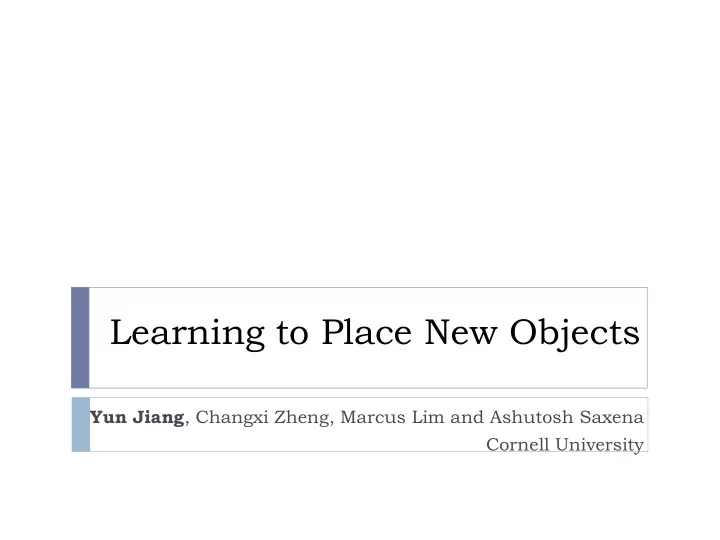

Learning to Place New Objects Yun Jiang , Changxi Zheng, Marcus Lim and Ashutosh Saxena Cornell University
Placing Novel Objects Robotic grasping has been studied for decades. How to place objects after grasping? Example scenarios: Arranging grocery in a fridge. Loading a dish-rack. Organizing a house. 2 Jiang, Zheng, Lim and Saxena
Placing Problem Formulation Input: point cloud of objects and placing areas (from Kinect). Output: a stable and preferred placement specified by 3D location/orientation of the object 3 Jiang, Zheng, Lim and Saxena
Challenges Where to place? complex (non-flat) areas Semantic preferences: shoes not on tables Which orientation to place in? Depends on different placing areas. 4 Jiang, Zheng, Lim and Saxena
Previous Work Where to place? Flat and clutter-free surface [M.J.Schuster et al., 2010] M.J.Schuster et al., 2010 How to execute placing? Given desired location to place, Path planning [Lozano-Perez et al., 2002]. Tactile feedback [Edsinger and Kemp, 2002]. A.Edsinger and C.C.Kemp, 2002 5 Jiang, Zheng, Lim and Saxena
Learning Approach Placing single object 6 Jiang, Zheng, Lim and Saxena
Stability Features Supporting contacts (12) Falling distance, Eigen values, center of mass, etc. contacts 7 Jiang, Zheng, Lim and Saxena
Stability Features Supporting contacts (12) Caging features (37) Height Horizontal distance from the placing area to the object (a) side view (b) top view 8 Jiang, Zheng, Lim and Saxena
Semantic Features Supporting contacts (12) Caging features (37) Histogram features (96) # points from object, placing area and their ratio (a) side view (b) top view 9 Jiang, Zheng, Lim and Saxena
Max-margin learning Features for each placement Labels Soft-margin support vector machine (SVM) Shared-sparsity in the parameters. 10 Jiang, Zheng, Lim and Saxena
Learning Approach 11 Jiang, Zheng, Lim and Saxena
Learning Experiments Finding best location and orientation 7 placing areas and 19 objects A total of 620 placements 12 Jiang, Zheng, Lim and Saxena
Robotic Experiments 13 Jiang, Zheng, Lim and Saxena
Robotic Experiments Objects/environments are never seen before by the robot! T otal 400 robotic trials. 14 Jiang, Zheng, Lim and Saxena
Placing multiple objects Task: placing multiple objects into multiple placing areas Challenges (1) stability (2) semantic preference (3) linear stacking (4) non-overlap Max-margin learning Inference as a linear programming problem [ Jiang, Zheng, Lim and Saxena, IJRR 2012 ] 15 Jiang, Zheng, Lim and Saxena
Experiments: Full Scene Semantics Finding semantically preferred placing area 98 objects from 16 categories 11 different placing areas 16 Jiang, Zheng, Lim and Saxena
Video 17 Jiang, Zheng, Lim and Saxena
Learning Object Arrangements using Human Context Learn human-object relationships Arrange objects meaningfully Jiang, Lim and Saxena, ICML’12 18 Jiang, Zheng, Lim and Saxena
Thank you! Learning to Place New Objects. Jiang, Zheng, Lim and Saxena, ICRA’12 . Learning to Place New Objects in a Scene. Jiang, Zheng, Lim and Saxena, IJRR ’12 Learning Object Arrangements in 3D Scenes using Human Context. Jiang, Lim and Saxena, ICML’12 Dataset for object placing & arrangements 98 objects from 16 categories, 40 placing areas 180 human labeled arrangements on 20 rooms and 47 objects http://pr.cs.cornell.edu/placingobjects/ 19 Jiang, Zheng, Lim and Saxena
Recommend
More recommend